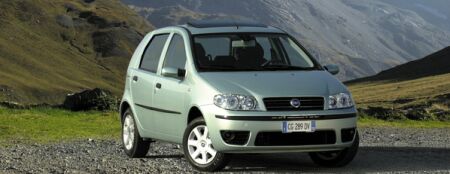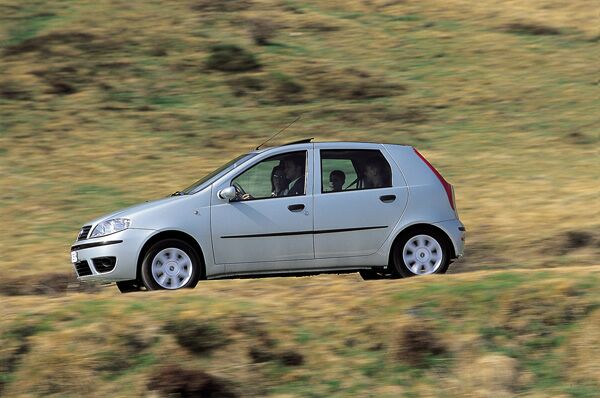
new models: Fiat Punto ( 2003 Restyling )
 |
| SAFETY
The Fiat Punto is one of the safest cars on the road. This is borne out, for example, by the fact that it can be fitted with six airbags: one for the driver, one for the passenger, two side bags and two tubular bags. Their operation (the bag in the steering wheel inflates fully in 30 milliseconds) is controlled by an electronic control unit that evaluates crash severity by sensors that are calibrated by means of a series of crashes carried out under laboratory conditions. The passenger airbag may also be deactivated manually so that a child can be carried on a backward facing child seat (the pretensioner remains active in this case). The braking system features two independent crossover hydraulic circuits to assure prompt, gradual braking and shorter stopping distances. Pedal travel is short so that brake servo specifications may be exploited to the full. The front discs measure 240 mm in diameter for vehicles with a 1.2 8v engine; 257 mm for vehicles equipped with 1.2 16v, 1.4 16v, 1.3 Mutijet and 1.9 JTD engines. New Fiat Puntos with the 100 bhp 1.9 Multijet and 1.8 16v engine come with 284 mm brakes. The brakes are ventilated, except for the two 1.2 Fire versions. Drum brakes are fitted at the rear on all versions, with the exception of the out-and-out sporty HGT equipped with 1.8 16v and 1.9 Multijet engines that is fitted with two discs. These feature self-centring shoes and automatic play take-up to ensure a short pedal travel that remains constant over time and also prompter braking. The 9-inch brake servo also facilitates braking and makes it more effective by reducing the effort required on the pedal. On right hand drive versions with ESP, the pedals and drive trains have been radically revised to obtain shorter travels and modulate braking action more effectively. Because diesel engines are heavier than petrol engines, they are fitted with a variable load-proportioning valve that distributes the braking effort correctly to the rear axle under all load conditions and reduces stopping distances. The load-proportioning valve is electronic on versions with ABS. The Fiat Punto was also one
of the first vehicles in this market band to offer an ultra-strong steel
protection cell. The car was also developed after assessing many possible
crash configurations and taking into account the tough US and Japanese
standards. The result is a car that is always safe and reliable in any
situation.
The ABS fitted to the New Fiat Punto (Bosch 8) offers four active sensors, four channels, an electronic control unit and eight solenoids. It is complemented by an EBD (Electronic Brakeforce Distribution). This system ensures that any wheel at the point of locking can brake as effectively as possible. In emergency situations, it also allows full directional control of the car by means of the steering wheel. The strength of the system lies in the active sensors that process the wheel speeds (without the intervention of the control unit). They can also read values close to zero (passive sensors cannot record speeds lower than 2.5 km/h) and are less sensitive to interference caused by electromagnetic fields. This advanced ABS is complemented by an electronic brakeforce distributor EBD. This divides braking action over all four wheels to prevent the rear wheels from locking and ensures a balanced car response under all conditions. The system also adapts system operation to wheel grip conditions and pad efficiency. It also reduces front brake temperatures and the brake servo thrust requirement. To ensure greater mastery of the car, the New Fiat Punto also offers the sophisticated Electronic Stability Program, a system that cuts in under near-limit conditions when car stability is at risk and helps the driver to control the car. To achieve this result, the ESP continually monitors tyre grip in both longitudinal and lateral directions. If the car skids, it cuts in to restore directionality and ride stability. It uses sensors to detect rotation of the car about its vertical axis (yaw speed), car lateral acceleration and the steering wheel angle set by the driver (which indicates the chosen direction). It then goes on to compare these data with parameters generated by a computer and establishes - via a complex mathematical model - whether the car is cornering within its grip limits or if the front or rear is about to skid (understeer or oversteer). To restore the correct trajectory, it then generates a yawing movement in the opposite direction to the movement that gave rise to the instability by braking the appropriate wheel (interior or exterior) individually and reducing engine power (via the throttle). This is the key attribute of the device created for the New Fiat Punto. It acts in a modulated fashion on the brakes to ensure the action is as smooth as possible (and the drive is not therefore disturbed). The engine power reduction is contained to ensure outstanding performance and great driving satisfaction at all times. The ESP is permanently engaged. The New Fiat Punto is fitted with a very sophisticated automatic traction control device to restrict drive wheel slip in the case of reduced road grip. This is known as ASR (Anti Slip Regulation) and comes as standard on all versions equipped with ESP. The ASR works at any speed and acts on the torque according to the measured grip coefficient. The device computes degree of slip on the basis of wheel rpm calculated by the ABS sensors and activates two different control systems to restore grip: - when an excessive power
demand causes both drive wheels to slip (e.g. as occurs during aquaplaning
or when accelerating over a road surface that is uneven, snow-covered or
icy), it reduces engine torque by reducing the throttle opening angle and
thus air flow;
The ASR maintains vehicle safety as much as possible and is particularly useful when grip is lost (icy multi-storey car park ramps are one example) and whenever the asphalt does not guarantee even friction. Another not inconsiderable advantage of the ASR is the lower stress exerted on mechanical parts such as the differential and gearbox due to more effective control of low speed take-off and traction. The ASR comes on automatically whenever the engine is started. To turn off the device, all you have to do is press a switch on the central console. When the ASR is active, a warning light on the control panel flashes. A control panel warning light comes on (with the switch led off), to indicate system faults or irregularities. ASR deactivation is required when snow chains are used because the wheel must be able to slip by tiny amounts to pile up the snow so that force can be transmitted to the ground and the ASR tends to avoid this type of action. The MSR (Motor Schleppmoment Regelung) cuts in when the gear is shifted down abruptly under conditions of low grip. This device restores torque to the engine to prevent the wheel skidding as a result of lock. The New Punto offers a device to assist with emergency braking. On vehicles with ESP, the function is carried out electronically by the ABS control unit and is referred to as HBA (Hydraulic Brake Assistance). In emergency braking situations, most drivers recognise a situation of danger and press the brake pedal very quickly. But not with sufficient force. This is because people, unless they are professional drivers, are used to applying a certain load to the brake pedal. As people tend to switch to autopilot mode when they carry out repetitive actions, the same level of force tends to be applied in all circumstances. On the new model, however, the brake assist devices cut in at this point. Although the pressure on the pedal is unchanged, the car is decelerated by the same amount, as it would be if it were braked with all the necessary force. Emergency brake assist devices can even help experienced drivers who brake quickly and apply the correct amount of force in emergencies. This is because the system reduces brake activation time in all cases, i.e. the period between the time when pressure begins to be applied to the pedal and the moment when the circuit reaches maximum pressure and is able to offer maximum performance. The Hill Holder helps drivers on hill starts. It operates when the ESP control unit perceives a change in vehicle gradient by means of a longitudinal acceleration sensor located on the floor under the passenger seat. During hill starts, the control unit is ready to intervene when first gear is engaged and both brake and clutch pedals are pressed. Front calliper pressure is thus maintained for about 1.5 seconds after the brake pedal is released so that the driver can set off with ease. The Hill Holder function does not operate when setting off downhill with the first speed engaged. The system performs in the same way with reverse engaged: during downhill starts, the system is active but deactivated during hill starts. |
 |
| <<< |